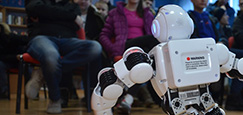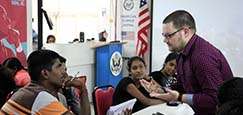U.S. PRESIDENTIAL ELECTIONS
PROGRAM TOOLKIT FOR AMERICAN SPACES
This resource toolkit is designed for programming at American Spaces to explain the function, process, and significance of the U.S. elections process.

DEFINITIONS
- Representative Democracy: a system of government in which citizens elect representatives to make decisions and create policies on their behalf, ensuring broader participation in governance.
- Popular Sovereignty: the authority and legitimacy of a government to come from the consent and will of the people it governs.
- Checks and Balances: a system in government where different branches (executive, legislative, and judicial) have distinct powers and roles to prevent any one branch from becoming too powerful or abusing its authority.
- Term: the length of time that a person holds a position in government. Presidents and vice presidents serve for four-year terms. Since the Twenty-second Amendment was adopted in 1951, the American presidency has been limited to a maximum of two terms.
- General election: an election in which candidates are chosen for office. The term is mostly used in the United States to distinguish general elections from primary elections.
- Primaries: elections in which a political party selects a candidate for an upcoming general election.
- Caucuses: meetings at which local members of a political party register their preference among candidates running for office or select delegates to attend a convention.
- Conventions: gatheringsheld every four years by most political parties to select the party’s presidential nominee and adopt a statement of party principles and goals known as the party platform.
- Electoral College: the group of presidential electors that is formed every four years during the presidential election for the sole purpose of voting for the president and vice president.
- Electors: people chosen by each state’s political parties who are qualified and bound by the U.S. Constitution and states’ laws to participate in the Electoral College process.
- Census: a count for official purposes, especially one to count the number of people living in a country and to collect information about them.
- Transfer of Power: the peaceful and orderly shift of authority from one government or leader to another, often occurring through elections or established constitutional processes.
- Inauguration: Ceremony for each new presidential term in which the president-elect of the United States is inaugurated as president by taking the presidential oath of office. The inauguration takes place for each new presidential term, even if the president is continuing in office for a second term.
America’s democratic system is characterized by a representative democracy where citizens elect officials to make decisions on their behalf. At its core is the belief in popular sovereignty, individual rights, and the rule of law. The United States operates with a federal system of government, dividing powers between a national government and individual states, which allows for both centralized and decentralized decision-making.
Every four years since 1797, when George Washington completed two terms as the United States’ first president, a nationwide election has been held for American citizens to vote for president and vice president. The president is the head of state, directs the executive branch of the federal government, and is the commander-in-chief of the U.S. military.
DECENTRALIZED ELECTIONS
In the United States, elections are decentralized. Rather than relying on a single national system, elections are overseen by thousands of state and local entities. Although states employ various methods for casting and counting votes, they all implement rigorous checks and balances to guarantee accurate vote counts. These include procedures such as recounts, audits, and pre-election inspections of voting systems.
MANY ELECTIONS, MANY LEADERS
The U.S. operates under a federalist democracy, characterized by an interconnected structure of federal, state, county, local, and municipal governments. Each year, there are hundreds of elections across the country – including the presidential election – to elect members of the U.S. House of Representatives, senators, state legislators, local officials, judges, and others.
THE PRESIDENTIAL PRIMARIES
In January, the United States begins its state-by-state nominating contests to select presidential candidates. This process includes primary elections and caucuses and spans almost six months. It finishes with the Republican and Democratic conventions held between July and September, where each party officially nominates its candidate for the November general election.
Primaries are statewide voting events where voters choose a party’s nominee for the general election. Each state and party sets its own rules for these primaries, including voter eligibility. Unlike caucuses, primaries allow voters to cast a secret ballot.
Caucuses, like primaries, are a method for political parties to choose their nominees for the general election. Unlike primaries, caucuses involve local meetings that take place at specific times and can last several hours. Participants discuss the candidates openly, and voting may be done by raising hands. While caucuses were once the primary method for selecting presidential nominees, today only a few states and territories use this approach.
In primaries and caucuses, voters select the nominees at the parties’ national conventions. These nominees will later compete in the general election in November. The number of delegates a state sends to the national conventions is proportional to its population.
THE GENERAL ELECTION
In the presidential general election, registered citizens can vote regardless of whether they participated in their state’s primary elections. Also, they can choose any presidential candidate, regardless of their party affiliation or previous voting choices.
MORE RESOURCES
Videos and Digital Media
- The U.S. Presidential Voting Process – State Department Content Commons
- Primaries and Caucuses | Khan Academy
- How the Electoral College Works
- PBS News Hour Student Reporting Labs | On Our Minds Election 2024 Podcast
Articles
- How Did We Get the Electoral College?
- How John Adams Managed a Peaceful Transition of Presidential Power | Smithsonian (smithsonianmag.com)
- A brief history of presidential primaries | Constitution Center
- How Political Conventions Began—And Changed | HISTORY
- Elections USA: In Brief Series (state.gov)
- Voting and elections | USAGov
OverDrive Books
American Spaces have access to the OverDrive platform via eLibraryUSA. OverDrive features American fiction and non-fiction ebooks, as well as audiobooks and other tools that support the six pillars of American Spaces. The following books related to U.S. elections are available in OverDrive:
Playing Politics (libbyapp.com) – With insights from social science, behavioral science, and mathematics, this ebook analyzes key factors in the process of electing a leader.
Votes of Confidence (libbyapp.com) – A detailed guide to the U.S. election cycle.
Electoral Campaigns, Media, and the New World of Digital Politics (libbyapp.com) – This book chronicles how Twitter, Facebook, Reddit, email, and memes are used successfully and unsuccessfully to influence elections.
KANOPY FILMS
The Candidates (2018) 74 minutes – Since 1996, the student body of Townsend Harris High School has been staging the longest running civics experiment in the form of simulating the American electoral process against the backdrop of the real one.
How Does American Democracy Work? (2020) 26 minutes
eLibraryUSA Scavenger Hunt
Audiences can test their knowledge of eLibraryUSA databases with this election-themed scavenger hunt.

Most people vote on Election Day, which falls on the first Tuesday after the first Monday in November. Depending on location, the voting period can include options such as absentee ballots, mail-in ballots, and early voting.
In the United States, there is no law that requires citizens to participate in local, state, or presidential elections.
THE ELECTORAL COLLEGE
The president and vice president are not elected directly by voters. Instead, they are selected through the Electoral College process, which was established by the Constitution’s framers as a compromise between a direct popular vote and a vote by Congress. The Electoral College is not a physical entity but a procedure that involves choosing electors, electors meeting to cast their votes for president and vice president, and Congress counting the votes of the electors.
MEMBERS OF THE ELECTORAL COLLEGE
There are a total of 538 electors, including three for Washington, D.C. Each state’s political parties choose their electors. Each state has a number of electors equal to the number of its members in the U.S. House of Representatives – determined by a census of the state’s population – plus its two senators.
In general, states with larger populations have more electoral votes. For example, California, the most populous state in the U.S., has 55 electoral votes, while Wyoming, the least populous, has the minimum of three. However, since electoral votes are distributed based on congressional representation, with each state receiving two Senate seats regardless of its population, the representation can differ significantly from one state to another.
WHAT IS THE PROCESS?
Once voters have cast their ballots for president, the votes are counted in each state. In 48 states and Washington, D.C., the candidate who receives the majority of the votes gets all the state’s electoral votes. Maine and Nebraska, however, use a proportional system to allocate their electors. To win the presidential election, a candidate must win at least 270 electoral votes. While a projected winner may be announced on election night, the Electoral College vote officially takes place in December when electors meet in their states.
The electors convene on the Tuesday after the second Wednesday in December following the general election. They meet in their respective states to cast their votes for president and vice president on separate ballots. These votes are recorded on a Certificate of Vote, which the electors prepare during their meeting.
On January 6 of the year following the electors’ meeting, a joint session of Congress counts each state’s electoral votes. Members of the House and Senate gather in the House Chamber for this official count. The vice president, as president of the Senate, oversees the count in a ceremonial role and announces the results. The president of the Senate then declares who, if anyone, has been elected president and vice president of the United States.
The president-elect is sworn in on January 20 of the year following the general election, officially taking office as president of the United States.
DISCUSSION QUESTIONS
- Why do free and fair elections matter?
- What happens in the case of an Electoral College tie?
- How do you navigate political biases in the news?
- Why is it important to have a peaceful transfer of power between presidential administrations?
- What are pros and cons of a system electing presidents by popular vote versus the electoral college?
- Compare and contrast the U.S. presidential election process with the system in place in your country to elect the head of state.
LESSON PLANS
The Electoral College Process | National Archives – In this activity, students will learn the steps in the Electoral College process, from Election Day to Inauguration Day. They will analyze historical primary sources from various presidential elections, each representing a different step in the process, and arrange them in the correct sequence.
This lesson has students explore the challenges that incoming administrations face during presidential transitions. Students will hear from historians and from White House staff to learn about previous presidential transitions and how the administrations worked together.
Teaching Resources for US Elections | Facing History & Ourselves – Resources on voting, media literacy, polarization, and bias to talk about U.S. elections
The views expressed in these links and resources do not necessarily reflect those of the U.S. government.
Updated April 2025









